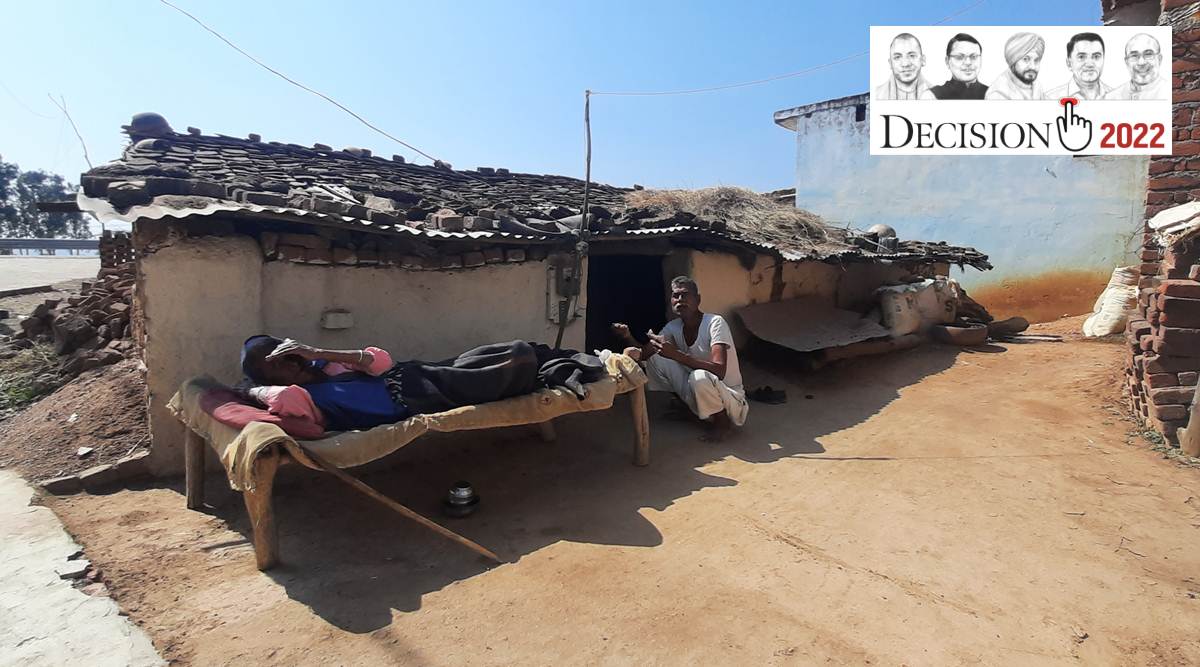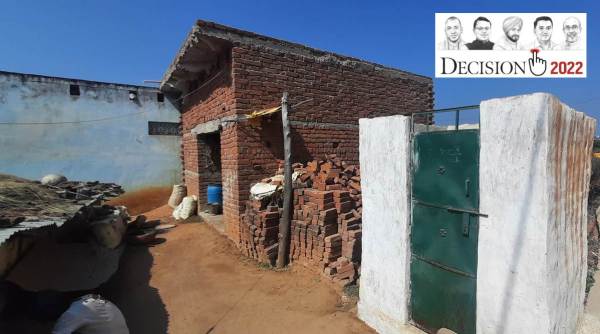 Bhairav Vishwakarma at his house in Saura, Charkhari constituency, Mahoba. (Express photo by Harikishan Sharma)
Bhairav Vishwakarma at his house in Saura, Charkhari constituency, Mahoba. (Express photo by Harikishan Sharma) * Over the last five years, Govind Das and family received Rs 1,20,849 in their bank accounts under the PM housing scheme, Swachh Bharat Mission, PM-Kisan, as Covid assistance by the Central and state governments, and in lieu of his children’s school mid-day meal. Besides, he has been getting 35 kg foodgrains at subsidised rates, and free foodgrain during the pandemic months, among other benefits.
* From Mahoba district, Geeta Devi Shriwas and her family have received Rs 1,52,000 in their bank accounts over a similar period under the housing scheme, Swachh Bharat Mission and PM-Kisan. Besides, the family has been getting foodgrains at subsidised rates and other pandemic measures.
* In the last five years, Ramashankar’s family, from Chitrakoot district, has received Rs 1,54,000 in their bank accounts under the housing scheme, Swachh Bharat Mission and PM-Kisan, as assistance to women Jan-Dhan account holders, and in lieu of his children’s mid-day meal.
 The house Bhairav Vishwakarma built with the Rs 1.20 lakh that he got under the PM Awas Yojana. (Express photo by Harikishan Sharma)
The house Bhairav Vishwakarma built with the Rs 1.20 lakh that he got under the PM Awas Yojana. (Express photo by Harikishan Sharma) Das, Geeta and Ramashankar live miles apart in UP’s rural Bundelkhand and belong to different castes, yet are bound by a common thread: they are all beneficiaries of government welfare schemes and talk about how, from a new electric meter to a toilet, they have seen and felt change in their lives.
In an election with few certainties and where caste and religion often dominate discourse, the labharthi varg – or beneficiaries of government welfare schemes – has become, to the BJP, an emblem of the “double engine” it hopes will blunt anti-incumbency.
The Indian Express tracked down several beneficiaries, checked their official records, to find that most have witnessed several firsts in their lifetimes: a-brick-and-mortar house; a toilet; LPG cylinders; a bank account. While this labharthi varg emerged with the launch of Direct Benefit Transfer schemes in 2013, the numbers have gone up since then as the number of schemes went up. For instance, the Indira Awas Scheme (IAY), which has been in operation since 1985-86, was restructured as the Pradhan Mantri Awas Yojana-Gramin in April 2016, after which the scheme saw a massive spike in numbers.
Manoj Kumar Singh, Additional Chief Secretary (Rural Development), Uttar Pradesh, said, “In the last five years, 26.5 lakh houses have been built under the scheme in UP, which is equal to the number of houses built in 15 years before the launch of PMAY-G in 2016.” He added that the amount of grant given under the scheme to build a house in rural areas has increased from Rs 75,000 to Rs 1,20,000.
Govind Das, 37, Jhansi
Das lives with his wife, three children and his father at Acchru Khirak Phutera village near Baruwa Sagar in Babina constituency of Jhansi district.
A Class 10 dropout, he earns his livelihood – Rs 5,000-6,000 a month – by tilling his quarter-acre farm, besides working as a labourer at NREGA sites and as a part-time worker at a factory in Orchha, Madhya Pradesh.
Last year, Das and his family received Rs 90,000 under the PM Awas Yojana-Gramin (PMAGY), the rural housing programme that started in 2016 as a restructured form of the Indira Aawas Yojana of the 1980s. The amount was credited to his father Dayaram’s bank account. However, Das said, he is yet to receive the remaining amount of Rs 30,000. Construction work on the one-room house is still on.
In 2019, the family received Rs 12,000 for the construction of a toilet under the Swachh Bharat Mission. They also got a tap-water connection under the Jal Jeevan Mission, but haven’t got water yet. “Yeh pipeline purani line se connect ki hui hai, isliye pani nahin aata (The pipe has been connected to an old pipeline. Therefore, they do not receive water),” he said.
Between February 25, 2019, and May 15, 2021, the family received eight installments of PM-Kisan, totaling Rs 16,000. They are yet to receive the last two installments. In all, 10 installments have been released under PM-Kisan till date since the launch of the scheme in 2018-19. Under PM-Kisan, the government provides Rs 6,000 per year in three installments to landholding farmer families.
Das and his wife, Pramila Devi, both have e-Shram cards, a Central scheme which entitles them to an accident insurance cover of Rs 2 lakh. They have also registered themselves with the Uttar Pradesh Building and Other Construction Workers Welfare Board, as part of which each of them is entitled to get a one-time Covid-19 relief of Rs 1,000. While Das has received his share, Pramila is yet to get her entitlement.
Das’s three children – a 17-year-old son, two daughters aged 10 and 12 — all go to school. Documents available with the family show that with schools shut during the pandemic, both his daughters got free foodgrains (a total of 51.9 kg) and Rs 1,849 in lieu of cooked food under the mid-day meal scheme at school.
His family also has an Antyodaya card that entitles them to receive 35 kg foodrains at subsidised rates under the National Food Security Act, 2013.
Besides, each member of the family has been getting 5 kg free foodgrain (30 kg in all) every month under the Pradhan Mantri Garib Kalyan Anna Yojana, a pandemic measure. In addition to this, the family has also been getting one kg each of gram dal, edible oil and salt every month — a state government measure during the pandemic.
All the adult members of Das’s family have a Jan-dhan account. However, his wife did not receive the Rs 500 monthly Covid assistance announced by the Centre for women account holders during the first Covid wave. While Das has an insurance cover under the Pradhan Mantri Suraksha Bima Yojana, for which an amount of Rs 12 is deducted from his bank account every year, the family does not have a card under Ayushman Bharat-Pradhan Mantri Jan Arogya Yojana (AB-PMJAY).
Das said the village has a health sub-center but no doctors are available there.
When asked what is the issue which he would like to raise during the election, Das, who belongs to the Kushwaha (OBC) caste, said, “koi plant lag jaaye ya kachhu ho jaye. Rojgar milat jaye bas (A factory should be set up so that we get some work),” he said, adding that stray cattle are also a big problem.
Geeta Devi Shriwas, 30
About 80 km away from the Das family, Geeta Devi lives with her husband, three children (two daughters and a son), her father-in-law and brother-in-law in Saura village in Charkhari assembly constituency of UP’s Mahoba district.
Her husband, Vijay Kumar, is a truck driver and earns Rs 8,000-10,000 a month. The family sends their children to a private school. “Sarkari school me padhai theek nahin hoti (Government schools do not provide good education),” says Geeta, who belongs to the Dhobi community, a Scheduled Caste.
The family is building a house with the Rs 1.20 lakh that was credited to her account under the PMAY-G scheme. The house is in her name.
The family has an Ayushman Bharat Card in her father-in-law Maiyadeen’s name that entitles them to free treatment of up to Rs 5 lakh a year. When asked whether he has used it, Maiyadeen said that there is no big hospital available in the locality.
All the adult members of the family have bank accounts and E-shram cards. However, Geeta says she did not receive the Rs 500 a month Covid assistance announced by the Central government.
Geeta’s family also has a NREGA job card.
In August last year, the family got an LPG gas cylinder under the Pradhan Mantri Ujjwala Yojana. They use it occasionally, Geeta said.
The family, which grows mustard and wheat on their 1 bigha, has received all 10 installments announced so far of PM-Kisan, totalling Rs 20,000.
Maiyadeen says he is happy that the government has given “equal respect to big and small farmers” under the scheme. “Earlier, under Akhilesh Yadav’s government, only rich farmers with 200-250 bigha got money; they had no regard for small farmers like us. Yogi ji ne bahut achchha kam kiya hai har aadmi ko samaan roop se samman diya hai… (Yogiji has done a very good job of giving equal respect to all farmers). Now a person who owns 100 bigha will get Rs 2,000, so will someone who owns 1 bigha,” he says.
Ramashankar, 52
About 220 km away lives Ramashankar in his unplastered house that’s surrounded by mustard fields at Moharwan village in Chitrakoot Assembly constituency. Ramashankar, who belongs to the Nishad community, lives with his wife, two sons and a daughter. The family grows wheat, paddy and mustard on their one-acre land.
Documents available with the family show his children received Rs 1,100 each from the state government to buy school uniforms and shoes. One of them has also received Rs 1,318 in lieu of the mid-day meal in addition to food grains.
In addition to the 35 kg foodgrains that they get at subsidised rates under the Food Security Act, the family has also been getting ration under the Centre’s pandemic-time allocation.
The family has a NREGA job card. Last year, Ramashankar got Rs 10,000 under the job scheme.
Last year, he started building a house with the Rs 1.20 lakh he got under PMAY-G, but had to stop the work when he ran out of money; the doors and windows are still to be installed. They also got Rs 12,000 for the construction of a toilet.
Ramashankar’s wife, Asha Devi, says she received the Centre’s monthly Covid-19 grant of Rs 500 for three months, with the amount credited in her Jan Dhan account.
The family has also received all 10 installments of PM-Kisan, totaling Rs 20,000, from March 2019 to January 2022.
While the family has an electricity connection, tap water pipelines under the Jal Jeevan Mission are yet to reach their home.
Ramashankar says the family has an LPG cylinder but he does not get it refilled regularly. “We have firewood. We use that,” he said.
Discussing the upcoming election, Ramashankar says the stray cattle menace is the biggest issue in his village. “We will vote for the party that gets rid of this problem. I have to stay up all night to save my crops,” he says.
- The Indian Express website has been rated GREEN for its credibility and trustworthiness by Newsguard, a global service that rates news sources for their journalistic standards.

